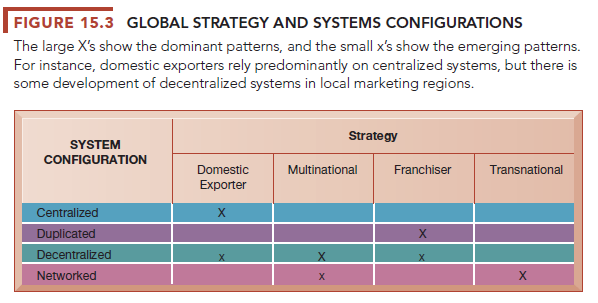Information technology and improvements in global telecommunications are giving international firms more flexibility to shape their global strategies. The configuration, management, and development of systems tend to follow the global strategy chosen. Figure 15.3 depicts the typical arrangements. By systems we mean the full range of activities involved in building and operating information systems: conception and alignment with the strategic business plan, systems development, and ongoing operation and maintenance. For the sake of simplicity, we consider four types of systems configuration. Centralized systems are those in which systems development and operation occur totally at the domestic home base. Duplicated systems are those in which development occurs at the home base but operations are handed over to autonomous units in foreign locations. Decentralized systems are those in which each foreign unit designs its own unique solutions and systems. Networked systems are those in which systems development and operations occur in an integrated and coordinated fashion across all units.

As can be seen in Figure 15.3, domestic exporters tend to have highly centralized systems in which a single domestic systems development staff develops worldwide applications. Multinationals offer a direct and striking contrast: Here, foreign units devise their own systems solutions based on local needs with few if any applications in common with headquarters (the exceptions being financial reporting and some telecommunications applications). Franchisers have the simplest systems structure: Like the products they sell, franchisers develop a single system usually at the home base and then replicate it around the world. Each unit, no matter where it is located, has identical applications. Last, the most ambitious form of systems development is found in transnational firms: Networked systems are those in which there is a solid, singular global environment for developing and operating systems. This usually presupposes a powerful telecommunications backbone, a culture of shared applications development, and a shared management culture that crosses cultural barriers. The networked systems structure is the most visible in financial services where the homogeneity of the product-money and money instruments—seems to overcome cultural barriers.
Source: Laudon Kenneth C., Laudon Jane Price (2020), Management Information Systems: Managing the Digital Firm, Pearson; 16th edition.

Youre so cool! I dont suppose Ive read something like this before. So good to find someone with some unique thoughts on this subject. realy thanks for starting this up. this web site is something that is wanted on the internet, someone with a bit originality. useful job for bringing one thing new to the web!